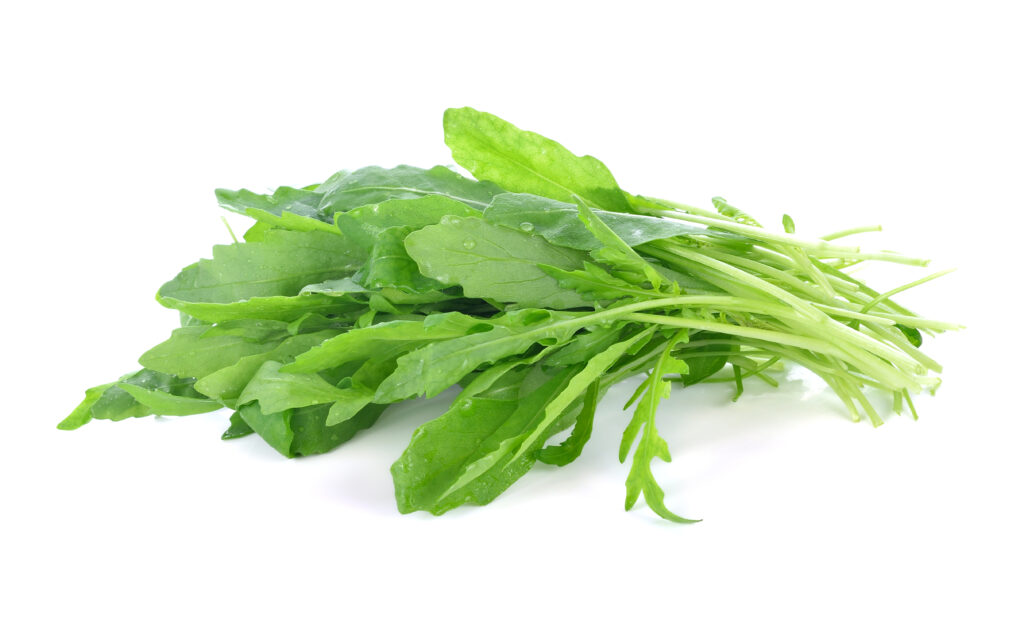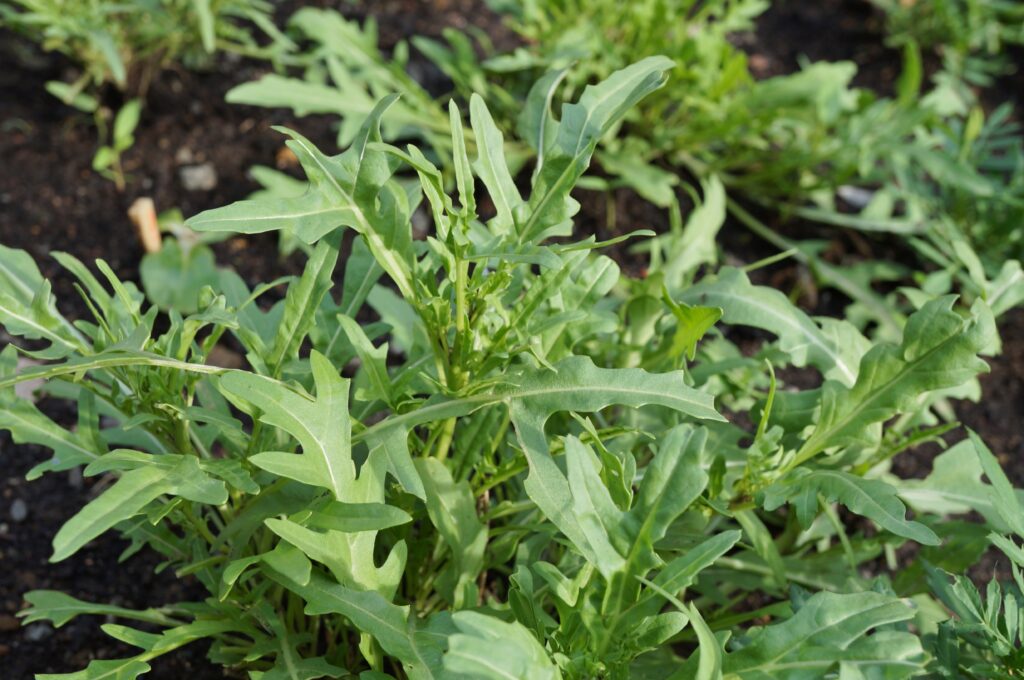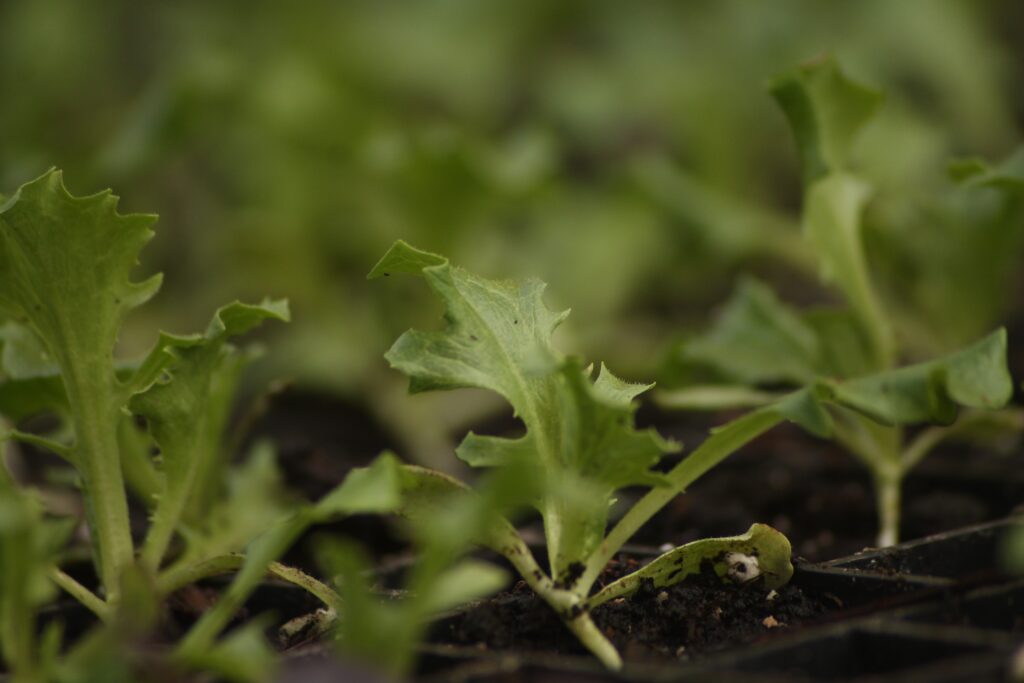A popular salad green that adds excellent texture and taste to a variety of dishes is arugula. This well-loved and commonly grown leafy green can be grown by all levels of gardeners. If you’re hoping to learn all you need to know to get started growing this tasty green, you’re in luck!
In this guide, we’ll cover arugula’s botanical classification, characteristics, and crucial information on successfully growing this excellent vegetable.
So, without further ado, let’s jump in!
Arugula: Botanical Classification and Characteristics

This leafy green is a part of the
Brassicaceae family
and belongs to the
Erucagenus of flowering plants.
©panuwat panyacharoen/Shutterstock.com
Arugula is an annual herbaceous plant native to the Mediterranean region. This leafy green is a part of the Brassicaceae family and belongs to the Eruca genus of flowering plants. Its botanical name is Eruca vesicaria although you may still find it referred to by its previous scientific names of Eruca sativa or Eruca vesicaria subspecies sativa.
People love to use this plant in various dishes for its peppery, slightly nutty, and slightly bitter flavor profile. The texture of this green is slightly crispy and has a similar consistency to raw spinach. The leaves of arugula are yellow-green to dark green and deeply loved. While the leaves are the most commonly eaten part of the plant, the flowers, young seed pods, and seeds are also edible.
How to Grow Arugula
Successfully growing arugula entails understanding what growing zones it’s hardy to, its ideal soil and light conditions, watering requirements, fertilizing requirements, and when and how to plant the seeds or young transplants.
Below, we’ll dive into each of these categories to help you have all the crucial information you need to help your crop thrive.
USDA Hardiness Zones
Like many other plants in the Brassicaceae family, arugula is quite hardy and adaptable. Gardeners in the US can plant this tough salad green from USDA hardiness zones 2a-11b. This covers all of the growing zones in the continental US.
If you’re looking for a hardy plant to get started as a beginner vegetable gardener, plants in the brassica family are an excellent choice.
How to Grow Arugula: Ideal Soil Conditions

If you’re looking for high-producing arugula, and your soil is mostly compacted clay, you’ll likely need to either amend it with compost, chopped bark, or composted leaves.
©Vika_Ya/Shutterstock.com
While arugula thrives best in loamy, fertile, and well-draining soil with a slightly acidic to neutral pH (6.0-7.0), it is quite tolerant of less-than-ideal soil conditions such as sandy or clay soils. While it doesn’t love having soggy roots, this adaptable plant can handle bouts of soggy soil without suffering damage. You’ll just need to make sure the soil has enough drainage so that the plant is able to recover.
If you’re looking for high-producing arugula, and your soil is mostly compacted clay, you’ll likely need to either amend it with compost, chopped bark or composted leaves. You can also use gypsum or build raised beds with better soil structure. For soil that is mostly sand, you’re in better shape as arugula is rather drought-tolerant and can handle the fast-draining nature of sand. If you want to improve its structure and ability to retain some moisture, you can add chopped sphagnum moss and compost, which will encourage proper drainage while retaining adequate moisture.
Sunlight Requirements
Ideally, you’ll want to grow arugula in full sun. This Mediterranean plant thrives in full sun conditions. In the partial sun, you’ll find this leafy green can become notably leggy with weakened stems. For the best results, plant arugula in a location where it receives at least 6 hours of full sunlight every day.
How to Grow Arugula: Watering Requirements

A good rule of thumb for arugula is to water when you notice that the top 1-2 inches of the soil are dry.
©EQRoy/Shutterstock.com
Generally, arugula plants must intake 1-1.5 inches of water weekly. The best watering routine ensures the soil stays moist but not soggy. A good rule of thumb for arugula is to water when you notice that the top 1-2 inches of the soil are dry. Frequent irrigation when it’s young is especially important to help your crop become well-established.
This plant does have a rather shallow root system, so frequent watering is often required as it can’t store moisture for long periods in its root system. Nonetheless, this tough leafy green can actually handle periods of drought quite well, which makes sense given its native environment is the somewhat arid Mediterranean region. Its native environment is characterized by dry summers, so periods of drought during its growing phase are normal in its natural habitat. The takeaway of this information shouldn’t be, however, to underwater your arugula, but rather to know that it will likely survive periods of drought if it’s otherwise in a healthy condition. Just remember, we’re aiming for thriving plants, not merely surviving!
How Often and How Much to Fertilize?
Arugula isn’t a heavy feeder, so depending on your soil type, you may not need to apply fertilizer. The key is to know if your soil is nitrogen-rich or not, which will depend on the health and population of the microbial community in the soil. Soil microbes are responsible for breaking down compounds that plants uptake as nutrients. If your soil lacks a healthy microbial community, you’re more likely to need to apply fertilizer in the form of compost or fertilizer mixes.
Pale, yellowing leaves and weak stems (when grown in full sun) can be a sign that your plant isn’t up taking enough nitrogen through its roots. If you notice this, you can try giving your crop a boost by applying a balanced NPK (nitrogen-phosphorus-potassium) quick-release fertilizer every 2-3 weeks during its growing season. Spread no more than an inch of fertilizer mix or compost, and make sure to leave a 2-3-inch buffer area around the plant to protect it from burns.
If you’re mixing fertilizer into the soil prior to planting, you’ll want to add it in 2 inches below where you’ll be planting the seeds or plant roots.
How to Grow Arugula: Direct Sowing Seeds
For most areas, you’ll want to direct sow arugula seeds in the spring after the last hard freeze has likely passed. You can also sow fall crops of arugula in the early fall. These hardy plants can germinate in soil temperatures as low as 40 degrees Fahrenheit, and many gardeners sow their arugula seeds once the soil becomes workable.
Sow your seeds in a sunny location at a depth of 1/8″. Space them out by five seeds per inch. You can space rows quite close together at about 6-12 inches apart. Once your seedlings have developed 4-5 leaves, you can thin them to about 6 inches apart.
Depending on the variety of arugula, you can expect your first harvest in 30-50 days after sowing.
Transplanting Young Arugula

Pick a day to plant your arugula that is cloudy and not windy, as sunny and windy conditions can increase the risk of transplant shock.
©HarmonyJoy/Shutterstock.com
When you don’t want to grow from seed, you can buy young arugula plants from a garden center, nursery, or some health food stores. If you buy plants that have been growing outside, you won’t need to acclimate them to the outdoors before planting.
If they had been growing in a greenhouse, you’ll want to acclimate them to outdoor conditions over a week. Start out by placing them in partial shade in temps above 45 degrees Fahrenheit. As they acclimate, increase their sun exposure and time outside until they are outside all day and night.
For best results transplanting arugula into your garden, follow the below steps:
- Pick a day to plant your arugula that is cloudy and not windy, as sunny and windy conditions can increase the risk of transplant shock.
- Prepare holes 4-6 inches apart that are about an inch deeper than the depth of the arugula containers.
- Remove the young arugula plants by turning the container upside down and squeezing the sides until the plant pops out. If the plant does not easily come out, tap the bottom of the container.
- Plant the arugula into each hole, and gently cover with soil without firmly tamping, as you don’t want to cause compaction.
- Thoroughly water each plant.
The photo featured at the top of this post is © Vika_Ya/Shutterstock.com
Thank you for reading! Have some feedback for us? Contact the AZ Animals editorial team.






